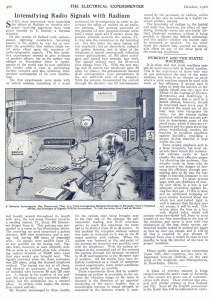Some most interesting facts regarding the effects of Radium on wireless telegraph receiving apparatus have been given recently by E. Bemier, a German scientist.
On the results of Szilard with radium-coated lightning conductors becoming known to the author he was led to consider the possibility that radium might exert some effect upon the reception of radio-telegraphic signals. The first tentative experiments seemed to give evidence of positive effects; but as the author was obliged to discontinue them in consequence of the world war he now publishes his results with a view to stimulating further research and also obtaining independent confirmation of his own conclusions.
The first experiments were made with an indoor antenna consisting of a wood rod loosely wound throughout its length with wire, the rod being directed towards a sending station, FL, about 300 kilometers distant from it. This antenna was suspended in a room. The receiving set used comprised a galena detector, 4000 ohm telephones, and a tuning coil having 800 turns of enameled wire. No signals were audible from FL at any position on the tuning coil. Signals were, however, at once distinctly audible as soon as a sealed glass tube containing radium bromide of 50,000 units (and thus very weak) was brought near. The signals vanished when the shunt resistance was 220 ohms, using the shunted telephone method. The tuning was not at all sharp, and showed no maximum for any length of included wire between 80 and 120 meters. A change in the position of the radium did not produce any noticeable differences; but the orientation has a marked effect. At certain wide angles the reception ceased entirely.
Mr. Bemier, encouraged by these results, continued his investigations in order to determine the effect of radium on an ordinary antenna. The antenna consisted of two parallel 1.5 mm phosphor-bronze wires held 1 meter apart and 8 meters above the ground, directed towards the station FL, as was also the connection to the receiving set. For this latter the same tuning coil was employed; but an electrolytic replaced the galena detector, and in place of the mirror galvanometer, of 500 ohms resistance and period two seconds, was used. The signals utilized were the 10-second time signals from FL. With the best tuning and 56 meters the telephones gave 80 ohms for silence; the galvanometer showed 20-21 microamperes (one microampere is the one millionth part of an ampere). With the antenna disconnected the current through the detector was 0.7 microampere. On the radium tube being brought near to the free end of the antenna the galvanometer reading was 50-53 microamperes; to reach this maximum the tuner had to be shifted from 56 to 48 meters. In this position the reception without radium was quite as mistuned as it was in the 56 meter position with radium. When the radium was fastened at the mid-point of the antenna no reception was possible, even with the telephones. With the radium arranged at the connected end of the antenna the current through the detector increased to 35-38 microamperes at the 40-meter tuner position. All the results have been definitely confirmed as a result of numerous control experiments, made under conditions as nearly similar as possible.
These experiments show that by suitably bringing up radium in proximity to the antenna the vibration image of the latter is changed in the direction of an apparent shortening of the wave; further, that a considerable increase in signal strength, as measured in the detector circuit, is occasioned by the proximity of radium, which must in any case be caused by a higher received primary current.
The proximity of radium to the tuning coil itself has, however, the effect of rendering distinctly worse the previously distinct telephonic reception, without it being possible to discern any definite mistuning, and this applies whether the radium tube be insulated or earthed. On the other hand, the radium tube exerted no noticeable effect on any of the other parts of the receiving equipment.
HUMIDITY AND THE STATIC MACHINE
It is often said that static machines cannot be used successfully in humid weather. This is the experience of those only who do not understand the care of the static machine, for there is no climate on earth where a static machine cannot be used with more or less efficiency if proper care is taken to keep the interior of the tightly closed case dry, says the Journal of Electrotherapeutics and Radiology. A static machine that is used in a humid climate, however, should be renovated once every year if it receives the usual use of the busy man who recognizes its value; for the nitrous oxides produced within the case are certain to deteriorate some of the metal parts, which if they are re-lacquered and the glass revolving plates re-shellacked, renders the machine in excellent condition against humidity, providing a proper drying material is kept within the case.
Some employ sulfuric acid in a large receptacle, but most observers have found the commercial calcium oxide in hard chunks the most effective means for absorbing the moisture. One mistake made by those who do not perceive the danger of lowering the efficiency through permitting dust to fly into the machine is that the container is not well covered. To place several bags, which one thickness of muslin over them, in a box is not adequate protection against letting the dust out. If this is done and an additional wrapping of good muslin fastened about the whole box and tacked tight in such a manner that the dust cannot escape, it will be well. Otherwise place the lime in a box with slatted sides, which will contain when two-thirds full, forty to sixty pounds of dry lime according to the size of the machine, and cover it over with two thicknesses of the best, finely woven, unbleached muslin tacked in around the edges so that no dust can escape, and it will be all that is required in any climate if changed from once a month to once in two months, to keep the interior of the case in proper condition.
Direct public wireless service connecting Japan with other countries, has been inaugurated between Ochiishi, on the east coast of the Kokkaido and Petropavlovsk, in Kamchatka, Siberia.
A chain of wireless stations is being erected around the entire coast of Australia so that vessels are never out of communication with shore. These stations also connect with similar stations at New Zealand and Fiji. Soon all the English possessions in the South Sea will be connected by radio.










